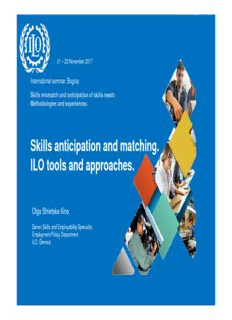
Skills anticipation and matching. ILO tools and approaches. PDF
Preview Skills anticipation and matching. ILO tools and approaches.
21 – 22 November 2017 International seminar, Bogota Skills mismatch and anticipation of skills needs Methodologies and experiences Skills anticipation and matching. ILO tools and approaches. Olga Strietska-Ilina Senior Skills and Employability Specialist, Employment Policy Department ILO, Geneva Global drivers of change and changing skill needs Technological change Globalisation and trade Demographic change Mobility of labour Change in work organisation Educational attainment Transition to environmental sustainbility and a low carbon ecnomy Demand for skills is changing faster than training is delivered Policy cycle Skill needs assessment & anticipation Skills development Evaluation of training policy / outcomes and their Curriculum design / relevance to the labour Competency standards market needs Skills development Monitoring of training relevance (delivery) Key ILO resources ‘Members should… support and facilitate research on human resources development and training, which could include: … identifying, measuring and forecasting the trends in supply and demand for competencies and qualifications in the labour market…’ ILO Recommendation 195 on HRD, 2004 “A mismatch between skills demand and supply has high economic and social costs and results from and contributes to structural unemployment. Early identification of current and future skills needs is part of a forward-looking strategy that reduces skills gaps.” Conclusions on skills for improved productivity, employment growth and development, ILC 2008 Anticipating future skills needs is recognised as the first building block of a robust training and skills strategies and policies G20 Training Strategy ILO skills anticipation and matching tools: Inter-agency compendium ILO skills anticipation and matching tools: Specific policy or driven • Sectoral approaches • Social dialogue • Elements of foresight as a change management tool Volume I: USING LABOUR MARKET INFORMATION 8 Labour market information (LMI) Any information concerning the Labour market size and information (LMI) composition of the labour market, the way it Skill needs functions, its assessment problems, and anticipation opportunities and employment- related intentions of its actors. Volume I: USING LABOUR MARKET INFORMATION Explains skills measurement Defines minimum LMI requirements for evidence- based and informed decision making Deals with standard statistics rather than surveys Provides examples of key indicators of skills supply, demand and mismatch Indicates the usual sources and institutions reposnsible for the data collection, flow and analysis
Description: